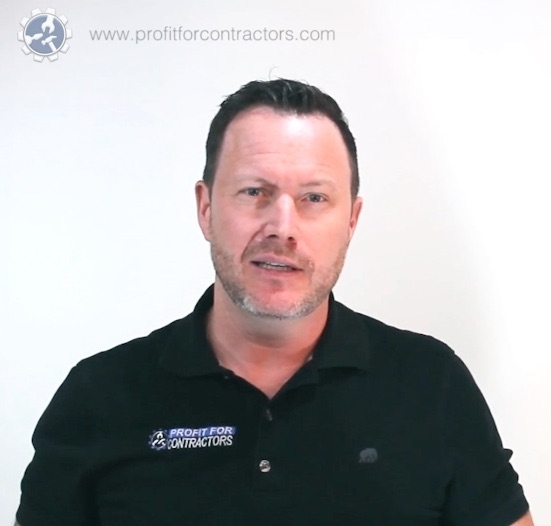
Uncategorized
Training & Education
Level Up • Are you pricing for profits, or poverty? • Andrew Houston
April 18, 2017 | By Andrew Houston

April 18, 2017 – Are you pricing for profits, or poverty? Do you know how much to quote to ensure you’re profitable? And do you know how to adjust your pricing based upon the cycles in your business?
Your numbers matter. They are the language of business. Sadly, too many contractors work hard throughout the year not knowing whether they’ll turn a profit.
Imagine you’re about to get on a plane with your family and, just as you’re boarding, you hear from the cockpit: “Do you know how to read these dials, because I sure don’t!”. Would you let your family get on that plane?
You might be laughing over the thought of this, but let’s look at it from the mindset of a business owner: you need to know every dial in your cockpit, and one of the most important dials is your “Break-Even Margin”. This is how much you have to charge on your quotes to get an amount that covers your costs exactly… 0:0 on the scoreboard.
When leveraged properly, your Break-Even Margin enables you to:
• Set a profit target/budget so you can quote profitably.
• Adjust how you price jobs so, when sales fluctuate, you’re able to you stay in the black.
• Adjust overhead costs to maximize your competitiveness.
Determining your Break-even Margin
So how do you calculate the margin you should add onto your quotes? Let’s start with calculating your Break-even Margin. (Visit tinyurl.com/zbxbtbv to use our simple Margin to Mark-up Calculator.)
All you need are 2 numbers:
1. Annual overhead expenses (a.k.a. fixed costs)
2. Estimated annual sales.
Annual Overhead Expenses = Break-even Margin
Estimated Annual Sales
Example #1
An electrical contractor has $250,000 in annual overhead expenses (e.g. lease, salaries, utilities, etc.). His estimated annual sales are $1 million.
$250,000 = 25% Break-even Margin
$1,000,000
At $1.5 million in sales, he would have a 17% Break-even Margin. (You can see how sales volume has a huge impact.)
Determining your Break-even Profit Margin
Break-even Profit Margin is my own term. I see this as the amount of profit the business owner wants to make beyond break-even, and it’s really easy to calculate once you know your Breakeven Margin. All you do is add the amount of profit you want to make to your annual overhead:
Example #2
Annual Overhead Expenses + Desired Profit = Break-even Profit Margin
Estimated Annual Sales
$250,000 + 100,000 = 35% Break-even Profit Margin
$1,000,000
Warning: when determining your “Sales Price” on a job, do not take your Direct Job Cost and simply multiply it by 1.35, because then you would be calculating your “Mark-up”, not your “Margin”. Note the difference:
• Mark-up % is the difference between a product’s cost and its selling price.
• Margin % is the amount of profit as a percentage of sales. This is the one to use.
To ensure you apply our targeted margins in Examples #1 and #2, you need to determine your Margin Conversion Rate (MCR).
1.0 – Break-even Profit Margin % = MRC
Going by Example #2
1.0 – 0.35 = 0.65 MCR
Cost = Sales Price
MCR
Example #3
If the Direct Job Cost is $1000, then
$1000 = $1538.00
0.65
See? If you simply multiplied your $1000 cost by 1.35 ($1350), you’d barely break even.
Ultimately, you need to understand the difference between mark-up and margin. Typically, understanding which to use can lead to a 5% increase on your bottom line. You also need to understand how to set weekly and daily profit targets for your crew, per department, which tells you how much to bill out and how much to charge out per hour, how to be able to quote by square footage versus always having to do a detailed quote, and so much more.
Don’t forget to join me for my next training webinar, How to Quote Profitably & Efficiently, June 13 (2 pm EST), where you will learn how to not quote yourself out of business, what you need to bill out daily based on your crew size, and more.♦
__________________
Andrew Houston is the owner and founder of Profit for Contractors. He has been consulting to trades business owners for nearly a decade, helping them improve their business skills so they can achieve their personal and business goals. A graduate of George Brown College, Andrew achieved Industrial Controls Licensed Electrician as well as Electronics Engineering Technologist. Visit www.profitforcontractors.com.
— Don’t forget to check out Andrew’s other Tradie Tip videos, located on our YouTube Channel, and CLICK HERE to check out some of our energetic webinars with Andrew. This column also appears in the upcoming May 2017 edition of Electrical Business Magazine.
Print this page